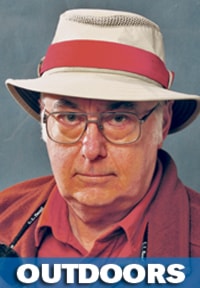It’s tough to praise the coming of June properly on the second last day of a cold and dry May with winds constantly playing drought dirges on sinuses like the painful pipes of Pan.
This will be an ode to Junes past, good, bad, outright horrible, but always interesting, all aspects of the month I’d choose if you rationed me to one to spend outdoors in Alberta.
We await the much-needed moisture of the annual June monsoon, pacing it on long-range forecasts as they taunt us with predicted 80 per cent chances of rain days that stay just ahead of us until they disappear altogether. Some Junes we do not get the monsoon at all; some years it never ends and, fortunately rarely, it is of historic force.
This year is the 10th anniversary of the worst June monsoon most of us, with any luck, will ever remember. June 19, 2005, was the kind of day poet James Russell Lowell praised: “And what is so rare as a day in June? Then, if ever, come perfect days.” So perfect that I headed west to try for my annual Father’s Day fish, but the day soon became rare because the annual mountain snow melt had collided with two days of torrential rains in the headwaters.
The Red Deer River valley at the Penhold Bridge on Hwy 592 was a brown lake, bridge traffic cautiously reduced to one vehicle at a time. At the viewpoint above the Dickson Dam, the crowd oohed and awed over 10-metre standing waves at the foot of the spillway. Just as I started for home, a lifelong resident of my Stump Ranch’s area cellphoned to suggest I come out anyway to see what I’d never see again.
I hope so. “They” dubbed this monsoon the “200-year flood.” The Clearwater River had pushed Clear Creek backwards into the North Raven, and the resulting lake was running over Hwy 54 at Raven. Prairie Creek was close to running over the bottom two bridges. In the bright sunshine, golden stoneflies were dying trying to deposit their eggs on the chocolate torrent.
Both my creekside hayfields had become moving lakes, with the tops of the fence posts barely surfacing. At the cabin, safely on very high ground, the rain gauge had overflowed at 10 inches in two days.
Fisheries biologists tell me it takes at least eight years for the aquatic insects and the trout in a stream to recover from a disaster like June, 2005; maybe more when it was preceded by the “Flood of the Century” in 2000. So it is encouraging when Prairie Creek regulars, two weeks ago, started reporting decent flights of salmon flies and the much smaller skwala stoneflies before their hatch-indicating chokecherries were in bloom. Even better, they were reporting taking some big old brown and bull trout from very low, clear water.
These anglers are now watching for the streamside wild roses to bloom and the golden stonefly hatch that predicts. Possibly the best day I had in my more than 50 years of fishing Prairie frequently was June 10, 2000, from 10 a.m. to 4 p.m. when, recovering from bypass surgery six months earlier, I plumb tuckered out from wading fast water and catching dozens of big brown trout eating my favourite golden stonefly imitation, my version of the Le Tort Hopper, yellow-bodied, sizes 8 or 10.
But you soon learn that June is not only about the linked progression of wildflowers, aquatic insect hatches, and good fishing. The renewal of life is to be seen in June along rivers and streams. One June, I turned and looked downstream to see, swimming across, the largest black bear sow I have ever seen and her three tiny black dots of cubs.
Their numbers are nowhere near what they once were out here, so I am always delighted in June to see the drama of the wounded ruffed grouse hen act when she tries to draw me away from her dozen fluff ball chicks.
There were places out here with nine feet of snow on the level in the winter of 2013. Thousands of deer died. So I will enjoy the does in June showing off their new fawns, or, like ruffed grouse hens, trying to lure me away from them.
One perfect June morning along the Clearwater River years ago, a doe jumped high up ahead, then stomped slowly away, white tail waving me on. I got her jump on yet another of my too-many new cameras, then nearly stepped on her fawn cached in the grass eyeing a dandelion fluff ball. I backed out of there and went fishing on the upper South Raven.
That afternoon we were rewarded with the blowing-in of that year’s much- needed June monsoon and the blowing out of rivers and streams for the rest of the month.
Bob Scammell is an award-winning columnist who lives in Red Deer. He can be reached at bscam@telusplanet.net.
